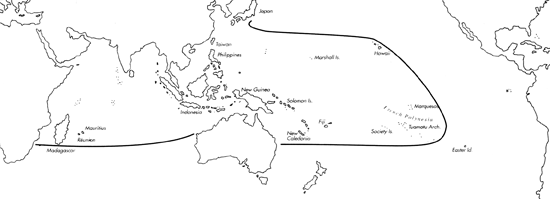Range: Entire Indo-Pacific region.
Description: Medium-sized to large, moderately solid. Last whorl usually narrowly cylindrical; outline straight and nearly parallel-sided at upper two-thirds, convex to straight towards base. Aperture wider at base than near shoulder. Shoulder subangulate to indistinct. Spire of moderate height; outline slightly convex to domed. Larval shell of 2.75-3 whorls, maximum diameter about 0.65 mm. First 6-7 postnuclear whorls tuberculate. Teleoconch sutural ramps almost flat, with 1 increasing to 4-10 spiral grooves. Last whorl with fine to strong, often granulose spiral ribs from base to shoulder; intervening grooves spirally striate and sometimes with one granulose spiral thread.
| Shell Morphometry | ||
|---|---|---|
| L | 40-95 mm | |
| RW | 0.11-0.27 g/mm | |
| (L 40-84 mm) | ||
| RD | 0.38-0.49 | |
| PMD | 0.60-0.77 | |
| RSH | 0.13-0.20 | |
Ground colour white. Last whorl with spiral rows of small orange to dark brown spots, and with variable orange, brown, or violet axial streaks and blotches, sometimes coalescing axially as well as spirally. Larval whorls white. Postnuclear sutural ramps blotched with orange to dark brown, outer margins with brown spots.
Periostracum yellow to brown, thin, almost opaque, smooth to rough.
In the Indian Ocean, animal pale to lemon yellow. Rostrum tipped with black. Siphon buff, with brown transverse lines dorsolaterally; tip and inferior of siphon black (Kohn, unpubl. observ.; Fainzibler et al., 1992). In N. Papua New Guinea, foot white to yellowish beige; dorsum mottled with tan to brown, less so medially. Rostrum and tentacles white to pale grey. Siphon brown basally, distal portion transversely banded with white, brown, grey and black toward tip (Chaberman, pers. comm., 1981; Pl. 76, Fig. 57). Operculum yellow and tiny in the Red Sea (Fainzilber et al., 1992) but rather long at Hansa Bay, Papua New Guinea (Chaberman, pers. comm., 1981).
Radular teeth stout, with an adapical barb opposite a blade; internal serration ending in a prominet cusp near the central waist; base with a strong spur (Peile, 1939).
Habitat and Habits: In 0.5-25 m, on sand bottoms and pinnacles of reef lagoons, in sand pockets of subtidal reef flats, and in caves among living corals. Reported to be molluscivorous though its radular teeth are said to resemble those of vermivorous C. imperialis (Peile, 1939; Calabrese, 1971).
Discussion: C. nussatella may only be mistaken for C. artoptus, which lives in deeper water. For the distinctions, see the DISCUSSION of the latter species.

C. nussatella range map
This section contains verbatim reproductions of the accounts of 316 species of Conus from the Indo-Pacific region, from Manual of the Living Conidae, by Röckel, Korn and Kohn (1995). They are reproduced with the kind permission of the present publisher, Conchbooks.
All plates and figures referred to in the text are also in Röckel, Korn & Kohn, 1995. Manual of the Living Conidae Vol. 1: Indo-Pacific Region.
The range maps have been modified so that each species account has it own map, rather than one map that showed the ranges of several species in the original work. This was necessary because each species account is on a separate page on the website and not confined to the order of accounts in the book.